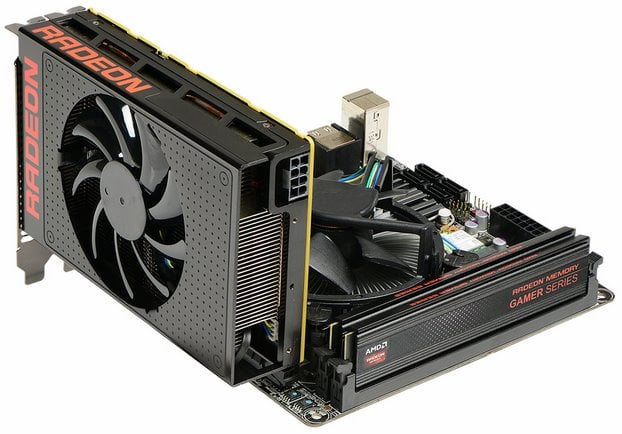AMD Radeon R9 Nano Review: Small But Mighty Fiji Unleashed
What Can You Do With An R9 Nano?
The story with the AMD Radeon R9 Nano isn’t necessarily about the multitude of technologies that went into making the card. The technologies at the core of Fiji, HBM and Asynchronous Compute are significant, of course, but we’ve covered all of those topics before. The Radeon R9 Nano story is mostly about its form factor, more manageable power envelope, and what those features and benefits can enable.
AMD says the “Radeon R9 Nano is engineered to be the ultimate solution for 4K and VR gaming in an incredibly small form factor.” The key take-away from that sentence is “incredibly small form factor”, because even in AMD’s own line-up, there are higher-performing solutions that feature the same base technology, i.e Fiji. There isn’t, however, anything nearly as small as the R9 Nano currently that offers the same kind of features and performance though.
The closest thing in terms of the Nano's size available at the moment is a mini, GeForce GTX 970 powered graphics card from Asus, the GeForce GTX 970 DirectUI mini. Here is that card, with the Radeon R9 Nano stacked on top. The cards are clearly of similar form factors, but as you'll see later, they do not perform alike. (Hint: The Nano is much faster.)
The Radeon R9 Nano is ideally suited for mini-ITX or other custom ultra-small-form factor builds where a larger card simply isn’t an option, something like the Alienware X51 R3 we recently reviewed comes to mind or mini-ITX builds like the one pictured above. There are multiple system builders pumping out small form factor gaming systems that aren’t much bigger than current-gen consoles and the Radeon R9 Nano is an ideal candidate for systems like those, budget permitting.
Do-it-yourself builders and enthusiasts will be forced to make a decision on the ultimate form factor of their systems. There are multiple mini-ITX chassis available that can accommodate larger graphics cards and beefy power supplies, and the R9 Nano's pricing places it in-line with some cards that can offer higher performance. The Lian-Li case pictured here, for example, can handle cards up to 8.66” long. Mini-ITX cases like the BitFenix Prodigy or Cooler Master Elite 130 can handle cards even bigger.
Speaking of the Cooler Master Elite 130...
AMD says the “Radeon R9 Nano is engineered to be the ultimate solution for 4K and VR gaming in an incredibly small form factor.” The key take-away from that sentence is “incredibly small form factor”, because even in AMD’s own line-up, there are higher-performing solutions that feature the same base technology, i.e Fiji. There isn’t, however, anything nearly as small as the R9 Nano currently that offers the same kind of features and performance though.
The closest thing in terms of the Nano's size available at the moment is a mini, GeForce GTX 970 powered graphics card from Asus, the GeForce GTX 970 DirectUI mini. Here is that card, with the Radeon R9 Nano stacked on top. The cards are clearly of similar form factors, but as you'll see later, they do not perform alike. (Hint: The Nano is much faster.)
The Radeon R9 Nano is ideally suited for mini-ITX or other custom ultra-small-form factor builds where a larger card simply isn’t an option, something like the Alienware X51 R3 we recently reviewed comes to mind or mini-ITX builds like the one pictured above. There are multiple system builders pumping out small form factor gaming systems that aren’t much bigger than current-gen consoles and the Radeon R9 Nano is an ideal candidate for systems like those, budget permitting.
Do-it-yourself builders and enthusiasts will be forced to make a decision on the ultimate form factor of their systems. There are multiple mini-ITX chassis available that can accommodate larger graphics cards and beefy power supplies, and the R9 Nano's pricing places it in-line with some cards that can offer higher performance. The Lian-Li case pictured here, for example, can handle cards up to 8.66” long. Mini-ITX cases like the BitFenix Prodigy or Cooler Master Elite 130 can handle cards even bigger.
Speaking of the Cooler Master Elite 130...









